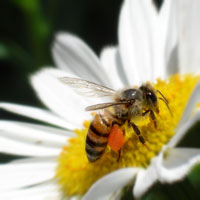
| Neonicontinoids: New 'DDT' Killing Bees and Natural World | 23 August 13 |

They are found in nectar and pollen of treated crops. Levels in soils, waterways, plants on field borders overlap with concentrations that are sufficient to control pests in crops. These concentrations commonly exceed a safe concentration and kill 50% of other insect pollinators, and impact local wildlife. Concentrations in nectar and pollen in crops are sufficient to impact substantially on bumblebee colonies. The studies that have been published show neonicotinides can last in the soil and environment for roughly nineteen years. This means the toxicity level of the presence of neonicotineds is likely to only become worse. The corporations that make these toxins, have claimed they were harmless to species other than the pests they targeted, as was claimed for DDT. People who have raised concerns, are being threatened, as was done in the days of rampant DDT usage. View 2013 University of Stirling reportView August 5, 2013 The Guardian article View April 28, 2013 The Guardian article View United States Environmental Protection Agency DDT page View DDT - Wikipedia Entry |
|
 Print version Print version |
Top |
